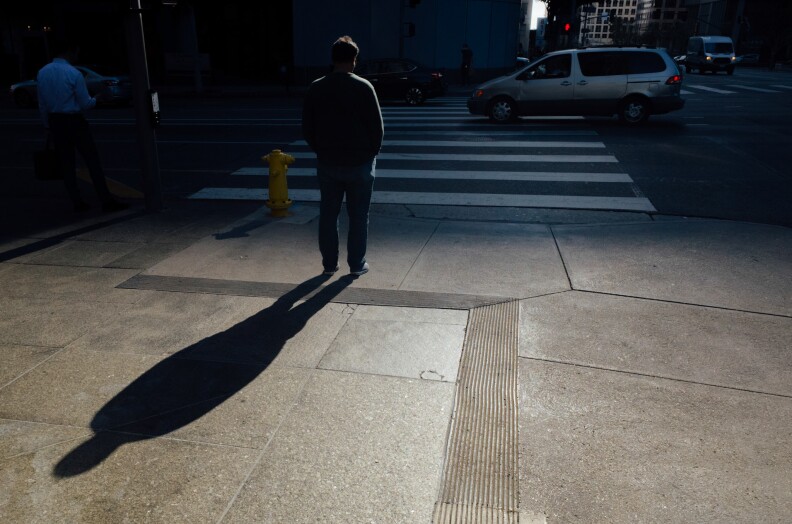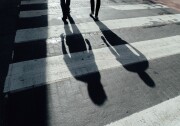Halfway Through 2021, LA Traffic Deaths Are On Track To Exceed Last Year’s Figures

You’ve likely noticed that seemingly everyone is back on the road in Los Angeles. We’ve reopened (for now), and we’re driving places and doing things. But more drivers on the road also means more crashes — and more people killed and injured on city streets.
There was an accepted understanding of traffic safety pre-pandemic: that fewer cars on the roads would mean fewer traffic deaths. That’s not what happened in L.A. and other U.S. cities last year, as more open roads enticed people that did drive to go too fast, leading to a higher rate of deadly crashes and a nearly unchanged death toll from 2019.
And just over halfway through 2021, the number of people killed and injured by drivers in L.A. is on pace to exceed 2020, which was one of the deadliest years on U.S. roads in more than a decade. That’s according to data compiled by the LAPD, which tracks traffic collisions in the city.
Simply put, our streets are dangerous either way: more cars on the road, more crashes, more deaths; fewer cars on the road, more speeding, more crashes, more deaths.
What The Latest Figures Show
Just over six months into 2021, Seleta Reynolds, general manager of the Los Angeles Department of Transportation, said her staff is observing that “congestion is back [and] traffic volumes are creeping back up.”
“Those really high-speed crashes are maybe diminishing, but simultaneously, we're seeing the normal relationship between traffic volumes and traffic safety kind of reestablish itself,” she said.
Unfortunately, that normal relationship in L.A. means a person is killed as a result of a crash about every 36 hours on average. For the first half of 2021, the city is averaging one traffic death about every 30 hours.
Severe and fatal crashes are up in nearly every category the LAPD tracks. Looking at department data through July 10 this year compared to 2020:
- DUI crashes have risen 20% overall
- Severe DUI crashes, in which a driver seriously injured someone, are up 73%
- Fatal DUI crashes have increased 9%
- Fatal hit-and-run crashes are up 25%
- Severe hit-and-run crashes have increased 20%
- Crashes in which a driver seriously injured a pedestrian are up 45%
- Crashes in which a driver seriously injured a bicyclist are up 34%
- Crashes in which a driver killed a bicyclist have increased 40%
The number of pedestrians killed by drivers this year is “holding about even” with 2020, Reynolds said — 56 people compared to 60 at the same point last year. Of course, the LAPD data reports are a couple weeks behind, and we know more pedestrians have been killed since July 10, including comedian Mat George, who was struck by a hit-and-run driver on July 17.

Reynolds is also concerned about surging deaths in the South L.A. and San Fernando Valley regions, where 100 people have died in crashes as of July 10, compared to 48 deaths combined in west and central L.A.
It’s not a mystery why more people are killed in those communities, she explained:
“We've got a lot of freeways that bisect the southern part of the city. And we've got a lot of arterials adjacent to those freeways, like Adams Boulevard, that have not received the kinds of safety treatments that we've been trying to get to across the city… The Valley is another part of the city that has a lot of really wide, fast streets — I think about streets like Victory and Vanowen — because it's been historically a very car-heavy and car dependent part of the city, due to its land-use patterns. Long distances that people travel to live their lives on a daily basis requires them to drive.”
LADOT does have a slate of improvements planned for Adams Boulevard, which include bike lanes, pedestrian beacons and protected left-turn signals. Construction is expected later this summer and into the fall, Reynolds said.
Reynolds is also bracing for an increase in the share of vulnerable road users — people walking and biking — killed and injured by drivers, especially with L.A.’s children returning to school in a few weeks.
“[It’s] really frustrating,” she said. “We're building the infrastructure as fast as we can, we're pushing for state legislative changes as hard as we can, and we just can't give up… the system bears some responsibility for these trends. We can't just focus on individual behavior — we have to fix the system itself.”
What Will It Take To Make LA Streets Safer?
Traffic safety officials, activists and academics I’ve talked to in recent years basically tell me the same thing: there’s no single magic solution that will curb traffic violence. Making streets safer depends on a variety of changes at both the personal and systemic level.
That includes drivers slowing down and keeping their attention on the road, investing in projects that redesign streets in a way that compels drivers to behave better (which the city has struggled to do), and changing laws to make it easier for L.A. and other cities to reduce speed limits and hold drivers accountable.

“We need people to know that this is a preventable crisis,” Reynolds said. “Their actions as drivers can make the difference and their willingness to be open to big changes on streets that they feel are very familiar can also mean the difference between somebody's family member coming home or not.”
-
The project will rename most of the terminals and all of the gates with the goal of world-class signage that leans into psychology.
-
The highly anticipated airport service likely won’t open until October 2025.
-
Big Sur's Highway 1 was built to maximize the breathtaking views of the cliffs and ocean at the cost of the road's longterm stability.
-
You can take the test in the comfort of your own home, twice.
-
The location in East Hollywood is the fourth official crosswalk to replace Crosswalk Collective LA's "unauthorized" efforts. Other DIY crosswalks have been removed by city officials.
-
Step one: Pull out that phone and snag photos of the pothole and car damage.









